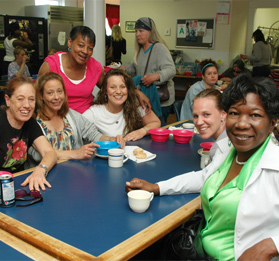
The more time I spend with rescue mission recovery programs, the more I’ve become convinced that the most important gift we can give homeless addicts is community, a place to belong. Homelessness is a state of complete disaffiliation–being cut off from all meaningful and supportive human relationships.
Suc cessful residential recovery programs actually provide a supportive “family” environment where homeless addicts can examine their lives and take the difficult initial steps toward a new, sober, and productive life.
There are two other important communities that program participants must become involved with so the process of change begun at the mission continues after they leave. The first is the Church, the Body of Christ, where program graduates experi ence fellowship with other believers and spiritual nurture. The second is the recovering community where involvement with support groups for recovering addicts give them a place to continue personal growth through mutual sharing and encour agement with others who have overcome addiction.
Creating an Environment That Encourages Change
So, how is a supportive “family” atmosphere created in a mission? It takes a coordinated effort by mission staff members to ensure that a therapeutic or conducive environment is main tained in a residential facility. Attention to the following dynam ics will greatly encourage a sense of order and help create an atmosphere that encourages change.
A. Drug Free — There must be immediate and serious consequences for any use of alcohol and drugs by program partici pants. The normal procedure is dismissal from the program for at least 30 days, often asking participants to return to the tran sient area of the mission. This rule helps to create an attitude of seriousness among all participants. If program people know they have “one drunk in the bank” they will surely use it.
B. Stable – Clearly communicated rules and policies maintained on a very consistent basis are the key to program stability. This involves clear expectations regarding which behaviors are rewarded, and which are censured. Favoritism and disunity among staff members regarding program policies seriously dam ages the sense of stability.
C. Segregated — People who are working on recov ery and change must be separated from other homeless people who are not in the program. Separate eating times and sleeping areas creates a special “chemistry” among program participants. It allows them to experi ence a fellowship where they can encourage one another toward change and growth.
D. Emotionally Safe – A sure sign that a person is beginning the process of genuine recovery is the return of the emotional life. They begin feeling again, and much of what they feel is pain and grief. To continue to recover, they must feel supported and know that they are in an environment where they can safely and freely express the struggles they are experiencing.
E. Confidential — Personal information about clients must stay within the program and the staff members directly working with those involved in the program (the “treatment team”). This is essential to maintain the trust of program participants.
F. Real Listening — There is healing value in self-revelation. This is greatly encouraged when program participants discover that other people, especially staff members, are genuinely interested in their individual needs, hopes, and aspirations. In my opinion, if each participant cannot receive a one-on-one session with a staff member at least once a week, the program is seriously understaffed.
G. Respect– Program participants must be treated with dignity, despite how much denial they’ have or what sort of mess they have made of their lives. Home less people are still God’s unique creations and deserv ing of the respect and the love and the honor that they have simply for that if nothing else.
H. Individualized Attention – We can only be of real help to people when we know what their real needs are. This begins with special efforts toward a formal ized needs assessment. Then, using the information we’ve gathered, an individualized written plan for recovery can be developed. Establishing simple goals and objectives allows both staff and residents to see whether there is progress in the ef forts toward change and growth. This also communicates to program participants that fact that they are truly important to the program staff. A rule of thumb: If you cannot provide at least a weekly one-on-one session with each program participant, you are seriously understaffed.
I. Every Activity Has Therapeutic Value — Most missions depend on long-term program participants to do much of the work to maintain their operations. Still, we must avoid giving program participants the feeling that they are being used. They need to know they are not just free labor, but that even the work they do has a therapeutic rationale that is also helping them at the same time. As you might imagine, none of these will be in place at your program by accident it is the responsibility of staff members and administrators to carefully watch over the therapeutic environment. Only by doing this can you create a place that motivates clients and promotes long-lasting change.

 In the US, twenty million children are expe riencing physical, verbal and emotional abuse from parents who are addicted to alcohol and/or drugs. This is tragic when we con sider that childhood is the foundation on which our entire lives are built.When a child’s efforts to bond with an addicted par ent are thwarted, the result is confusion and intense anxiety. In order to survive in a home devoid of healthy parental love, limits, and consistency, they must develop “survival skills” very early in life.
In the US, twenty million children are expe riencing physical, verbal and emotional abuse from parents who are addicted to alcohol and/or drugs. This is tragic when we con sider that childhood is the foundation on which our entire lives are built.When a child’s efforts to bond with an addicted par ent are thwarted, the result is confusion and intense anxiety. In order to survive in a home devoid of healthy parental love, limits, and consistency, they must develop “survival skills” very early in life. The Twelve Steps originated with Alcoholics Anonymous in the mid 1930’s. Besides being used to help alcoholics and drug addicts, the Twelve Steps have been used in support groups for family members, over-eaters, compulsive gamblers, and even for those desiring to escape from sexual addiction. These Steps formed the basis of treatment and counseling activities at New Creation Center where I served as Executive Director for ten years in the 1980’s. In the past few years, a movement recognizing the power of the Twelve Steps has sprung up among evangelical Christians concerned with those struggling with various addictions.
The Twelve Steps originated with Alcoholics Anonymous in the mid 1930’s. Besides being used to help alcoholics and drug addicts, the Twelve Steps have been used in support groups for family members, over-eaters, compulsive gamblers, and even for those desiring to escape from sexual addiction. These Steps formed the basis of treatment and counseling activities at New Creation Center where I served as Executive Director for ten years in the 1980’s. In the past few years, a movement recognizing the power of the Twelve Steps has sprung up among evangelical Christians concerned with those struggling with various addictions.

